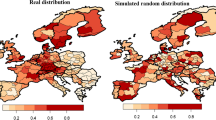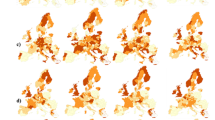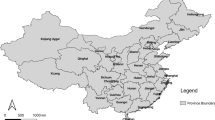Abstract
The paper focuses on a simultaneous consideration of both spatial heterogeneity and spatial autocorrelation in the context of European regional innovation activities. A new class of data generating processes, the Mixed Geographically Weighted Regression—Spatial Autoregressive model, is the main instrument of the analysis. We deal with 220 European regions, and the components of the Regional Innovation Scoreboard 2019 are the basis of the analysis. Patent Cooperation Treaty applications are used as a measure of innovation output, and Scientific publications among the top-10% most cited publications worldwide, Research & Development expenditure in the business sector, Small and Medium-Sized Enterprises introducing product or process innovations and Human resources in science and technology are included as innovation inputs. The main research hypothesis is that there are spatial innovation spillovers among the European regions. Changes in innovation inputs in a specific region affect the patent applications not only in this region but these changes might also significantly impact neighbouring regions. At the same time, we assume that the effects of changes in innovation inputs differ across regions, mainly between regions belonging to the top innovators and lagging regions. The results indicate that a spatial differentiation of the model parameters and spatial spillovers matter for innovation output. We detect significant differences between advanced and lagging regions. Therefore, heterogeneous responses to regional policy measures should be considered, and it is necessary to apply a more individual approach to the regional development of innovation activities.







Similar content being viewed by others
Notes
Cyprus, Estonia, Latvia, Luxembourg and Malta are included at the country level, as in these countries, NUTS 1 and NUTS 2 levels are identical to the country territory.
For Serbia, official NUTS codes are not yet available, and therefore unofficial codes were used (see Hollanders et al. 2019).
As a spatial structure criterion among regions, a spatial weighting matrix of queen contiguity form was chosen and used in all parts of our spatial analysis. This form of spatial weights defines neighbours as spatial units (regions) sharing a common edge or a common vertex (Anselin and Rey 2014). Corresponding spatial weights are taking non-zero values when the regions are neighbours, and zero values otherwise. For more details related to spatial weighting matrices and formulas for the Getis-Ord statistic see LeSage and Pace (2009).
HRST are people who fulfil one of the following conditions: (1) have successfully completed a tertiary level education; (2) not formally qualified as above but employed in a scientific and technical occupation where the above qualifications are normally required (Eurostat 2020b).
It is also necessary to mention that the innovation activities of multi-establishment enterprises are usually assigned to the region where the head office is located. Therefore, there is a risk that regions without head offices score lower on these indicators, as some of the activities in these regions are assigned to those regions with head offices. To minimise this risk, the regional RIS data excludes large firms (which are more likely to have multiple establishments in different regions) and only focuses on SMEs (Hollanders et al. 2019).
For more details, see Eurostat (2020c).
It is necessary to mention that the MGWR-SAR model estimation in mgwrsar R package (Geniaux and Martinetti 2018) also allows spatially constant parameter estimation. Since the MGWR-SAR estimate provides local estimates for all regions, we have moved away from the inclusion of multiple dummy variables of global character and prefer separate analyses for different groups of regions.
The GWR results are provided by the author on request.
The regions whose GDP per capita is less than 75% of the average GDP of the EU-27.
All boxplots (box width) are presented with respect to the group sample size. Sample size by groups: Less Developed—65 regions, Non-Less Developed—155 regions, Rural—53 regions, Non-Rural—167 regions, Post Socialist—59 regions, Non-Post Socialist—161 regions.
For further innovation inputs, given the scope of the paper, we only present an analysis with respect to the less developed regions vs more developed regions.
For more details, see Morisson and Pattinson (2020).
Interreg Europe (2021).
References
Acs ZJ, Anselin L, Varga A (2002) Patents and innovation counts as measures of regional production of new knowledge. Res Policy 31:1069–1085
Anselin L, Rey SJ (2014) Modern spatial econometrics in practice. GeoDa Press, Chicago
Anselin L, Varga A (1997) Local geographic spillovers between university research and high technology innovations. J Urban Econ 42:422–448
Anselin L, Varga A, Acs Z (2000a) Geographical spillovers and university research: a spatial econometric perspective. Growth Change 31:501–515
Anselin L, Varga A, Acs Z (2000b) Geographic and sectoral characteristics of academic knowledge externalities. Papers Regional Science 79:435–443
Audretsch DB, Feldman MP (1996) R&D spillovers and the geography of innovation and production. Am Econ Rev 86:630–640
Audretsch DB, Feldman MP (2004) Knowledge spillovers and the geography of innovation. Cities Geogr 4:2713–2739
Brunsdon C, Fotheringham A, Charlton M (1996) Geographically weighted regression: a method for exploring spatial nonstationarity. Geogr Anal 28(4):281–298
Brunsdon C, Fotheringham A, Charlton M (1999) Some notes on parametric significance tests for geographically weighted regression. J Regional Sci 39(3):497–524
Charlot S, Crescenzi R, Musoleli A (2015) Econometric modelling of the regional knowledge production function in Europe. J Econ Geogr 15:1227–1259
Chocholatá M (2020) Spatial variations in the educational performance in Slovak districts. Stat Stat Econ J 100(2):193–203
Diebolt C, Hippe R (2019) The long-run impact of human capital on innovation and economic development in the regions of Europe. Appl Econ 51:542–563
Eurostat (2020a) https://ec.europa.eu/eurostat/. Accessed: 20 Dec 2020
Eurostat (2020b) https://ec.europa.eu/eurostat/cache/metadata/en/hrst_esms.htm. Accessed: 20 Dec 2020
Eurostat (2020c) https://ec.europa.eu/eurostat/web/rural-development/methodology. Accessed: 20 Dec 2020
Feldman MP (1994) The geography of innovation. Kluwer Academic Publishers, Dordrecht
Feldman MP, Florida R (1994) The geographic sources of innovation: technological infrastructure and product innovation in the United States. Ann Assoc Am Geogr 84:210–229
Fingleton B, Le Gallo J (2010) Endogeneity in a spatial context: properties of estimators. In: Páez A, Le Gallo J, Buliung RN, Dall’erba S (eds) Progress in spatial analysis. Methods and applications. Springer, Berlin, Heidelberg
Fotheringham AS, Brunsdon C, Charlton M (1999) Some notes on parametric significance tests for geographically weighted regression. J Reg Sci 39:497–524
Furková A (2016) The Innovative clusters in the EU: the sensitivity analysis of the spatial weight matrix construction. In: Quantitative methods in economics: multiple criteria decision making XVIII. International scientific conference Vrátna, pp 106–113
Furková A (2019) Spatial spillovers and European Union regional innovation activities. Cent Eur J Oper Res 27(3):815–834
Furková A (2020) R&D Spillover effects: impact of R&D expenditure in the business sector on innovation activities. In: 38th international conference on mathematical methods in economics: conference proceedings Mendel University in Brno, pp 116–121
Geniaux G, Martinetti D (2018) A new method for dealing simultaneously with spatial autocorrelation and spatial heterogeneity in regression models. Reg Sci Urban Econ 72:74–85. https://doi.org/10.1016/j.regsciurbeco.2017.04.001
Gorzelak G (ed) (2015) Growth-innovation-competitiveness: fostering cohesion in central and Eastern Europe. GRINCOH Project Final Report, Contr. Nr. 290657
Griliches Z (1979) Issues in assessing the contribution of research and development to productivity growth. Bell J Econ 10:92–116
Guastella G, van Oort F (2015) Regional heterogeneity and interregional research Spillovers in European innovation: modelling and policy implications. Reg Stud 49(11):1–16
Hollanders H, Es-Sadki N, Mekelbach I (2019) Regional Innovation Scoreboard 2019. https://ec.europa.eu/growth/sites/growth/files/ris2019.pdf. Accessed: 1 Mar 2020
Interreg Europe (2021) https://www.interregeurope.eu/policylearning/good-practices/. Accessed: 5 Aug 2021
Jaffe AB (1989) Real effects of academic research. Am Econ Rev 79:957–970
Jaffe AB, Trajtenberg M, Henderson R (1993) Geographic localization of knowledge spillovers as evidenced by patent citations. Q J Econ 63:577–598
Khan BZ (2012) Of time and space: a spatial analysis of technological Spillovers among patents and unpatented innovations in the nineteenth century. https://www.nber.org/papers/w20732. Accessed: 10 Mar 2017
Kumar I (2008) Innovation clusters: a study of patents and citations ESRI international user conference. https://proceedings.esri.com/library/userconf/proc08/papers/papers/pap_1688.pdf. Accessed: 10 Mar 2017
LeSage J, Pace K (2009) Introduction to spatial econometrics. Chapman and Hall/CRC, Boca Raton
Leung Y, Mei C, Zhang W (2000) Testing for spatial autocorrelation among the residuals of the geographically weighted regression. Environ Plan A 32:871–890
Mei C, He S, Fang K (2004) A note on the mixed geographically weighted regression model. J Reg Sci 44:143–157
Moreno R, Paci R, Usai S (2005a) Spatial spillovers and innovation activity in European regions. Environ Plan A 37:1793–1812
Moreno R, Paci R, Usai S (2005b) Innovation clusters in the European regions. https://crenos.unica.it/crenos/sites/default/files/wp/05-12.pdf. Accessed: 22 Apr 2017
Morisson, A, Pattinson, M (2020) University-Industry Collaboration. Lille: Interreg Europe Policy Learning Platform. https://www.interregeurope.eu/fileadmin/user_upload/plp_uploads/policy_briefs/2020-01-17_Policy_Brief_University-Industry_Collaboration.pdf. Accessed: 5 Aug 2021
Pace RK, LeSage JP (2004) Spatial autoregressive local estimation. Spatial econometrics and spatial statistics. Palgrave MacMillan, New York
Pakes A, Griliches Z (1980) Patents and R&D at the firm level: a first look. Econ Lett 4:377–381
Acknowledgements
This work was supported by the Grant Agency of Slovak Republic—VEGA 1/0193/20 “Impact of spatial spillover effects on innovation activities and development of EU regions”.
Author information
Authors and Affiliations
Corresponding author
Ethics declarations
Conflict of interest
A. Furková declares that she has no competing interests.
Additional information
Publisher’s Note
Springer Nature remains neutral with regard to jurisdictional claims in published maps and institutional affiliations.
Rights and permissions
About this article
Cite this article
Furková, A. Simultaneous consideration of spatial heterogeneity and spatial autocorrelation in European innovation: a spatial econometric approach based on the MGWR-SAR estimation. Rev Reg Res 41, 157–184 (2021). https://doi.org/10.1007/s10037-021-00160-z
Accepted:
Published:
Issue Date:
DOI: https://doi.org/10.1007/s10037-021-00160-z
Keywords
- Mixed Geographically Weighted Regression - Spatial Autoregressive Model
- Spatial Heterogeneity
- Spatial Autocorrelation
- European innovation




